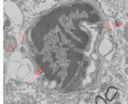(Press-News.org) Scientists now have a better understanding of how short DNA strands decompose in microseconds. A European team found new fragmentation pathways that occur universally when DNA strands are exposed to metal ions from a family of alkaline and alkaline earth elements. These ions tend to replace protons in the DNA backbone and at the same time induce a reactive conformation leading more readily to fragmentation. These findings by Andreas Piekarczyk, from the University of Iceland, and colleagues have been published in a study in EPJ D. They could contribute to optimising cancerous tumour therapy through a greater understanding of how radiation and its by-products, reactive intermediate particles, interact with complex DNA structures.
In cancer radiation therapy, it is not the radiation itself that directly damages the DNA strands, or oligonucleotides. But rather, it is the secondary reactive particles, leading to the creation of charged intermediates. Here, the authors have studied one of these charged intermediates in the form of so-called protonated metastable DNA hexamers.
To do so, the authors created selected oligonucleotide-metal-ion complexes that they selected to have between zero and six metal ions. They then followed these complexes' fragmentation reactions using a technique called time-of-flight mass spectrometry. By comparing the different species, they could deduce how the underlying metal-ion-induced oligonucleotide fragmentation works.
They discovered that metal ion-induced fragmentation of oligonucleotides is universal with all alkaline and alkaline earth metal ions, for example, lithium, Li+; potassium, K+; rubidium, Rb+; magnesium, Mg2+ and calcium, Ca2+. They had previously reached the same conclusion for sodium ions—which are ubiquitous in nature, in the form of sodium chloride, or salt. Once the number of sodium ions per nucleotide is high enough, the study shows, it triggers an unexpected oligonucleotide fragmentation reaction.
INFORMATION:
Reference: A. Piekarczyk, I. Bald, H. D. Flosadottir, B. Ómarsson, A. Lafosse, O. Ingolfssson (2014), Influence of metal ion complexation on the metastable fragmentation of DNA oligohexamers, European Physical Journal D DOI 10.1140/epjd/e2014-40838-7.
The full-text article is available to journalists on request.
Improving tumour radiation therapy: When basic ions break DNA down
A new study relevant for cancer radiation therapy shows that DNA building blocks are susceptible to fragmentation
2014-07-16
ELSE PRESS RELEASES FROM THIS DATE:
Researchers advance understanding in immune response to infectious disease
2014-07-16
University of Leicester researchers have released evidence substantiating an unexpected dual role of an important component of the immune system.
Findings by researchers at the University's Department of Infection, Immunity and Inflammation – including three PhD graduates – are published in a paper for the journal 'Medical Microbiology and Immunology'.
The paper presents significant new findings about the protein properdin – an important part of the immune system. It is a positive regulator in the alternative pathway of complement activation – which means it plays a ...
What increases the neuronal plasticity of endogenous NSCs after focal cerebral ischemia?
2014-07-16
Stem cells can substitute the lost cells after central nervous system injury, decrease nervous tissue damage and promote neurofunctional recovery. Many brain injury models, including middle cerebral artery occlusion and traumatic brain injury models, have confirmed that neural stem cells (NSCs) can migrate from subventricular zone to injured cerebral cortex. But the mechanism underlying activation of endogenous NSCs in the ischemic brain remains unclear. Dr. Hyung-Seok Kim, Chonnam National University Medical School, Korea and his team revealed that NSCs were activated ...
Age-related changes in lateral ventricular width and periventricular white matter by DTI
2014-07-16
Ventricular enlargement has been suggested as a structural biomarker for normal aging and progression of some illnesses, such as Alzheimer's disease. However, the question of how this structural change in the brain in normal elderly affects change of white matters remains a topic of interest and concern. Dr. Sang Seok Yeo, College of Medicine, Yeungnam University, Republic of Korea, and his team performed a diffusion tensor imaging (DTI) study to investigate the question. They detected four regions of interest in the periventricular white matter of 60 normal subjected aged ...
Does intravenous transplantation of BMSCs promote neural regeneration after TBI?
2014-07-16
The brain has a low renewable capacity for self-repair and generation of new functional neurons in the treatment of trauma, inflammation and cerebral diseases. Cytotherapy is one option to regenerate central nervous system that aim at replacing the functional depleted cells due to traumatic brain injury (TBI). Bone marrow mesenchymal stem cells (BMSCs) are also considered a candidate for cytotherapy because they can differentiate into neurons/nerve cells, pass across blood-brain barrier, migrate into the injured region, secrete neurotrophic factor, and provide microenvironment ...
Cooperation among humans, a question of age
2014-07-16
This news release is available in Spanish.
The new research paper, which reports on one of the first experimental studies in the world to analyze how cooperative attitudes evolve in different age ranges, was written by the professors from the OpenSystems research group of the Department Fundamental Physics at the Universidad de Barcelona (UB), Josep Perelló and Mario Gutiérrez-Roig, Anxo Sánchez, of the Complex Systems Interdisciplinary Group (Grupo Interdisciplinar de Sistemas Complejos - GISC) of the Mathematics Department at the Universidad Carlos III de ...
Zhichan decoction increases dopaminergic neurons from transplanted NSCs in PD
2014-07-16
There is an increasing interest in Parkinson's disease (PD) treatment by increasing dopamine content and reducing dopaminergic metabolites in the brain. Xuming Yang, Shanghai Municipal Hospital of Traditional Chinese Medicine, China and his team detected dopamine content and dopaminergic metabolites in the midbrain of PD rats, which were treated by neural stem cell (NSC) transplantation and Zhichan decoction administration, using high-performance liquid chromatography, and determined global optimization of dihydroxyphenylacetic acid and homovanillic acid levels using genetic ...
Chrysophanol attenuates injury to hippocampal neurons in lead-exposed neonatal mice
2014-07-16
Previous studies have shown that chrysophanol protects against learning and memory impairments in lead-exposed adult mice. Ji Zhang, Hebei North University, China, proposed a hypothesis that chrysophanol can alleviate learning and memory dysfunction and hippocampal injury in lead-exposed neonatal mice. Results showed that chrysophanol alleviated hippocampal neuronal cytoplasmic edema, promoted mitochondrial crista fusion, significantly improved learning and memory abilities, decreased lead content in blood, brain, heart, spleen, liver and kidney, increased superoxide dismutase ...
Donating a kidney may make it difficult to change or initiate life and health insurance
2014-07-16
People who selflessly step up and donate a kidney can face insurance challenges afterwards, despite the lack of evidence that they have increased health risks. The finding, which comes from a new study published in the American Journal of Transplantation, suggests that actions by insurers may create unnecessary burden and stress for those choosing to donate and could negatively impact the likelihood of live kidney donation.
The impact of kidney donation on the ability to change or initiate health or life insurance following donation is unknown. To investigate, Dorry ...
Live kidney donors face 'pointless' insurance troubles
2014-07-16
Healthy living kidney donors often face pointless post-donation hurdles when seeking or changing health or life insurance, according to results of a new study by Johns Hopkins researchers.
"Living donors are some of the healthiest people in the United States. They're heavily screened before they're approved for donation and should be easily insurable," says study leader Dorry Segev, M.D., Ph.D., M.H.S., an associate professor of surgery and epidemiology at The Johns Hopkins University.
Under terms of the Patient Protection and Affordable Care Act (ACA), health insurance ...
New knowledge about the brain's effective bouncer
2014-07-16
Research from the University of Copenhagen is shedding new light on the brain's complicated barrier tissue. The blood-brain barrier is an effective barrier which protects the brain, but which at the same time makes it difficult to treat diseases such as Alzheimer's. In an in vitro blood-brain barrier, researchers can recreate the brain's transport processes for the benefit of the development of new pharmaceuticals for the brain. The new research findings are published in the AAPS Journal.
Ninety-five per cent of all tested pharmacological agents for treating brain disorders ...
LAST 30 PRESS RELEASES:
Fecal tests reveal active termite attacks
Uterine fibroids linked to elevated heart disease risk
Dual use of cigarettes and vapes can reduce risks of smoking and help smokers quit
New bioelectronics device based on hydrogel- elastomer conductive nanomembranes
More yield through heterosis: IPK research team decodes gene interaction
James Webb telescope reveals spectacular atmospheric escape
ICE-CSIC leads a pioneering study on the feasibility of asteroid mining
Dramatic rise in young people using mental health services
Be careful trusting TikTok for gout advice
A study by the University of Seville links the vanishing of the specific heats at absolute zero with the principle of entropy increase
Anxiety and insomnia may lower natural killer cell count, potentially repressing immune function
How parasitic, asexual plants evolve and live
Research spotlight: A subset of patients with depression could benefit from anti-inflammatory treatment
New fully digital design paves the way for scalable probabilistic computing
Membrane electrode assembly design for high-efficiency anion exchange membrane water electrolysis
U.S. debt ceiling disputes show measurable impact on global crude oil markets
Climate extremes triggered rare coral disease and mass mortality on the Great Barrier Reef
Direct observation reveals “two-in-one” roles of plasma turbulence
Humans rank between meerkats and beavers in monogamy ‘league table’
US fossil reveals early mass-burial event and ancient microbial attack
Sedative choice could improve outcomes for breathing tube patients
New superconducting thin film for quantum computer chips
Simulations reveal protein "dynamin" constricts cell membranes by loosening its grip
Nearly 1 in 5 UK emergency department patients cared for in corridors/waiting rooms
Heavy energy drink intake may pose serious stroke risk, doctors warn
Violence against women and children among top health threats: New global study reveals disease burden far larger than previously estimated
Predicting who is at risk of developing type 1 diabetes, as new drugs now available
New gene-mapping method unlocks hidden drivers of cancer
Ocean current and seabed shape influence warm water circulation under ice shelves
Call to increase funding for ‘invisible’ Deaf victim-survivors of domestic abuse
[Press-News.org] Improving tumour radiation therapy: When basic ions break DNA downA new study relevant for cancer radiation therapy shows that DNA building blocks are susceptible to fragmentation

